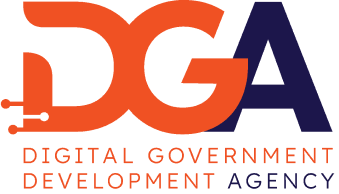Citizen Portal
The Digital Government Development Agency (Public Organization) (DGA) has developed the Citizen Portal system as a central platform to consolidate government services, facilitating citizens’access to government services online. This initiative is under Section 10 (5) of the Digitalization of Public Administration and Service Delivery Act B.E. 2562 (2019), which mandates the DGA to “support the integration of digital services across government agencies to provide seamless services as defined by the Digital Government Development Committee to ease access for the public.”
This effort is also a part of Thailand’s Digital Government Development Plan 2020-2022, Strategy 1, Program 1, Project 1, which focuses on developing a one-stop platform for public service delivery.
In addition, DGA has studied, analyzed, designed, and developed the Citizen Portal system since the end of 2020 and officially launched it in September 2021. As of January 15, 2022, the service has been used approximately 170,000 times (app downloads), with 1.1 million transactions processed through the system by over 77,000 users. The system has provided 45 services from 29 government agencies. DGA, in collaboration with the Office of the Public Sector Development Commission (OPDC), has engaged in discussions with related agencies involved in services within the Citizen Portal Master Plan (Citizen Portal Roadmap) for a three-year period. The goal is to continue connecting services from agencies to the portal to ensure that citizens can easily and seamlessly access comprehensive government services.
Benefits for Agencies:
- For Citizens: Citizens can conveniently access government services anytime, anywhere, through digital channels.
- For Service Providers: Service-providing agencies can expand their service channels to include digital platforms, facilitating easier access and convenience for the public.
Learning media
https://www.youtube.com/embed/35BQ9DaoVLg
Technical Characteristics:
The Citizen Portal system has been developed as an innovative platform that leverages digital technology to support the delivery of government services (Innovation Platform).
The Citizen Portal has been designed as a “Super App”, meaning it is a platform with integrated basic functionalities that allow participating agencies (“Partner Apps” or “Mini Apps”) to embed their specific services into the “Super App.” This design enables users to access various services from different providers without needing to switch between different apps.
This concept has become widely adopted in the business world, with applications like WeChat, Line, Grab, and GoJek leading the way. In this case, government agencies can easily integrate their services into the portal and apply basic features such as digital identity verification without developing these functionalities from scratch. This approach will significantly simplify and accelerate the development of digital government services in the future.
Identity Proofing and Authentication
The Citizen Portal system is designed with an identity proofing and authentication method that complies with the Digital ID Standard for Government Services for Thai citizens. This standard, developed by the Digital Government Development Agency (DGA), has been approved by the Digital Government Development Committee and is in the process of being published in the Royal Gazette.
Citizens are required to complete Identity Proofing before accessing any data or services on the Citizen Portal. The identity proofing process is as follows (for more details and visual guidance, visit this link https://ทางรัฐ.com/?page_id=1192).
- Citizens present their ID card to the system so that the system can read the data from the ID card image using Optical Character Recognition (OCR) technology.
- The system checks ID card status and verifies the accuracy of the data on the card online with the Department of Provincial Administration, using the same method that the Revenue Department employs for verifying the identity of taxpayers during online tax filing.
- The system compares the face image on the ID card with a live image of the applicant using Face Recognition with Liveness Detection, employing a highly reliable method
- Once identity verification is completed, citizens can create a user account and password, which can be used to access various government services through the Government Digital ID system (GDID) provided by the Digital Government Development Agency (DGA). Moreover, a PIN code can also be set up for future access to the application.
The identity verification process described has an Identity Assurance Level (IAL) of
1.3, based on the IT standard recommendation “Guidelines for the Use of Digital ID in Thailand – Registration and Identity Verification” (ETDA 19-2561), as set by the Electronic Transactions Development Agency (ETDA). In addition, citizens can verify their identity via the D.Dopa application from the Department of Provincial Administration or through Smart Government Kiosks provided by the Digital Government Development Agency (Public Organization) (DGA) (with 119 kiosks nationwide). This method achieves a higher IAL of 2.3. DGA is currently working with relevant agencies to enable citizens to upgrade their account assurance level by operating Know Your Customer (KYC) verification at designated service points or kiosks. Furthermore, partnerships with trusted service providers such as National Digital ID (NDID) are being established, allowing citizens to use verified accounts from these providers to access various government services.
Citizen Portal users do not need to verify their identity every time they log in. They can
access the application using either a PIN Code or Biometric authentication. However, if a user has been inactive for an extended period or switches to a new mobile device, they must reverify their identities. This requires logging in with their registered username and password from the initial signup process, along with One-Time Password (OTP) verification. This ensures compliance with the Digital ID standards for government services applicable to Thai nationals.
If a member forgets their password, they can click the “Forgot Password” button to reset it. A new password can be set through the contact information provided during the registration process.
Architectural Characteristics
The architecture of digital government services, including the central portal for citizens (Citizen Portal), can be summarized in the diagram below.
Different services for service requesters through Citizen Portal involve multiple microservices provided by DGA as follows:
- Digital ID System: Supports identity proofing and authentication for citizens.
- Citizen Portal: Facilitates access to various government services.
- Service Backend System: Supports the operations of service-providing agencies.
- Government Data Exchange (GDX): Enables data integration from relevant agencies to support citizen services, such as population registry data from the Department of Provincial Administration and corporate registration data from the Department of Business Development.
In providing services to service requesters, the microservices collaborate together according to the system flow shown above as follows:
- Identity Verification (Login): The requester logs in to the Digital ID system. If the requester does not have an account, they must first create one by providing personal information for identity proofing, which includes full name, citizen ID number, date of birth, and the laser code on the back of the ID card.
- Post-Authentication Process: Once the identity is successfully verified, the Digital ID system directs the requester to the Citizen Portal screen and sends the user profile data to the Citizen Portal.
- Service Selection: The requester uses Citizen Portal to select the desired service and provides any necessary details related to the service request.
- Data Request via GDX: The Citizen Portal sends a data request to the Government Data Exchange (GDX) to request the required information by linking with the systems of the relevant agencies.
- Data Request to Service Backend: GDX forwards the data request to the Service Backend system of the relevant agency to retrieve the necessary data.
- Processing of Data Request: The Service Backend processes the data request and sends the requested information back through GDX.
- Return of Information: GDX sends the data related to the service back to the Citizen Portal.
Data Display: The Citizen Portal processes the data received from the relevant agency and displays the information to the requester.
Legal Provisions Related to the Digital Service System
The Digitalization of Public Administration and Service Delivery , B.E. 2562 (2019), Section 4
This section aims to leverage the effectiveness of government administration and the provision of public services by making them more convenient, fast, and effective. It directs government agencies to provide administrative services and public services through digital channels, ensuring that the management and integration of public sector data and operations are aligned, securely connected, and governed with transparency and accountability. The goal is to increase efficiency, facilitate better service delivery, improve public access to services, and ensure the proper disclosure of public information while fostering public participation from all sectors.
Digital Government Development Agency (Public Organization) (DGA)
- The Digitalization of Public Administration and Service Delivery , B.E. 2562 (2019), Section 10 (5) “Support the integration of digital services across government agencies to provide seamless public services, as specified by the Digital Government Development Committee, in order to facilitate public convenience.”
- The Royal Decree on the Establishment of the Office of the Digital Government Development Agency (Public Organization), B.E. 2561 (2018), Section 8 (5)
“Develop integrated digital government services at a single point where the public can access services conveniently, quickly, and securely.” - The Royal Decree on Criteria and Procedures for Good Governance (No. 2), B.E. 2562 (2019), Section 10
“In the initial stage, the Digital Government Development Agency (Public Organization) shall establish a central digital platform for government agencies to provide public services and to facilitate coordination between them within ninety (90) days from the effective date of this Royal Decree.”
Security of the Citizen Portal System
The Citizen Portal is hosted on a cloud system managed and operated by the Digital Government Development Agency (Public Organization) (DGA). This government cloud service has a stability level (SLA) of no less than 99.5%. The system is designed with robust data theft prevention measures and is highly secure, certified to meet the ISO/IEC 27001: 2013 standard for Information Security Management Systems (ISMS).
However, all related applications and systems operate in compliance with the Computer Crime Act (No. 2), B.E. 2560 (2017) and the Cybersecurity Act, B.E. 2562 (2019) to ensure the security and integrity of the digital services provided to the public.
In addition, the Government Data Exchange (GDX) system has been developed with a focus on security, as outlined below:
- The development of applications, systems, and platforms by the Digital Government Development Agency (Public Organization) (DGA) is carried out in accordance with ISO/IEC 9001 standards.
- Before any application, system, or platform is launched for public use, it must receive comprehensive testing. This includes both functional testing and other non-functional tests,
such as performance testing and security testing. The results of these tests must demonstrate that the system functions effectively, operates with high availability, and has minimal security risks.
DGA conducts security testing of applications and platforms (Security Test) using at least two methods as follows:
- Static Application Security Testing (SAST) This method involves reviewing the source code of the developed applications and platforms to identify potential programming vulnerabilities that could be exploited by attackers or malicious parties.
- Vulnerability Assessment (VA) This method involves assessing the installed applications and platforms as a whole to determine if they have any security risks arising from improper settings or insufficiently secure infrastructure.
Contact for Service Requests
- General citizens interested in using the service can access it immediately at the website https://info.go.th.
- Government agencies interested in using the service can contact the DGA Contact Center at Tel: 02-612-6060 or by email at [email protected].

